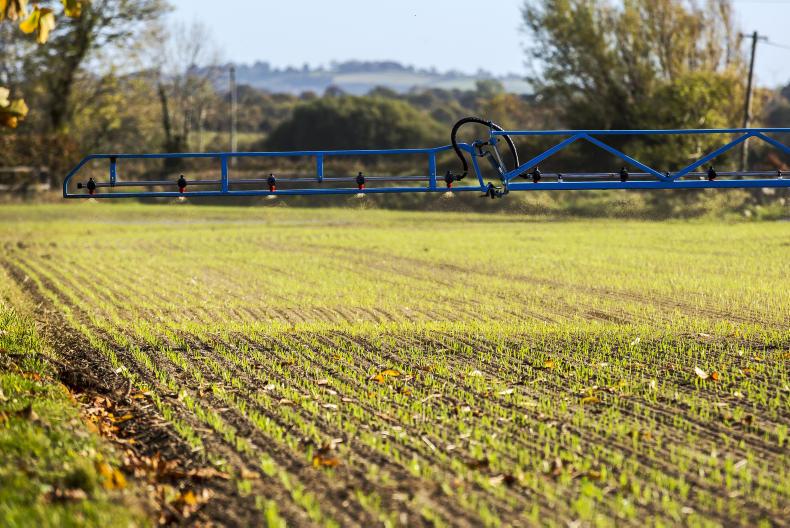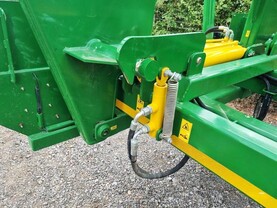This week we revisit growers from Kildare, Down and Kerry. Ground work is nearly complete with all growers. The good autumnal weather has meant that all crops are nearly fully emerged and are developing very well. Slug pressure is low across the board with all growers, while autumn aphicides have been applied in Kerry.

Athy, Co Kildare
Rain has once again returned to Athy but virtually all field work is now complete on Andrew’s farm. Despite having received around 60mm last week, ground conditions are still reasonable. “The coulter we used on the seed drill this year was higher disturbance but it hasn’t really made a difference to ground conditions,” explains Andrew.
His winter oat and wheat crops emerged slower than expected, with the tramlines just about visible last week. Crows were a particular issue this year he explains.
“We never normally have crows here but this year is different.”
He sowed his Cellule winter wheat on 17 October in great conditions. Using seed with a TGW of 37g, he sowed 370 seeds/m2 aiming for a plant stand of 270 plants/m2 at 75% establishment. He used home saved seed which wasn’t dressed.
“You’ll seldom harvest seed with less disease in it in Ireland than this year,” Andrew explains. The crop received a pre-emerge spray of Firebird (0.3l/ha) and he intends on applying a follow-up application of Vigon this week.

Andrew's Husky oats emerging alongside a companion crop of lupins.
Accidental companion crop
He moved onto sowing Husky winter oats shortly after. The crop was sown at 420 seeds/m2 with a TGW of 44g, aiming for 75% establishment. He appears to have an accidental companion crop with some of his oats his year. Lupin volunteers from last season are now growing alongside his winter oats. The winter oats received a pre-emerge spray of DFF (0.25l/ha) and will receive a follow up herbicide in the spring. His Cassia winter barley is developing very well and received Vigon (0.5l/ha) and DFF (0.15l/ha) last month. While there is an odd slug present, pressure isn’t high. His spring cover crops continue to develop, having responded well to the mild back end. “The vetches are now big and tangly, the phacelia is in flower, the radish is bulking in size and there’s even a bit of clover visible in the crop,” Andrew remarked.
“We generally leave the hedge cutting until as late as we can in order to let the birds eat any berries first. We have a little hedge cutting done around winter crops but none done on spring crops”

Poyntzpass, Co Down
Good settled weather continues in Poyntzpass and ground conditions remain excellent. Last Wednesday was the first real wet day in quite a while explains Simon. As temperatures are still relatively mild, crops continue to grow.
His DK Extential and DK Exclaim oilseed crop is around one foot in height, which is ahead of normal for this time of year. He will apply a fungicide in the coming weeks and possibly a separate growth regulator which will depend on if the mild temperatures keep up. He expects to see pigeons in the crop soon.
His winter wheat has all emerged with close to full emergence. He currently has half of the crop sprayed with Shooter (4.0l/ha), a broad spectrum broad-leaved herbicide which will also target annual meadow grass. All of his ground received compost, but Simon explains that the composting process kills any weed seeds present, so the risk of contamination is low.
Establishment of his winter oats is also high and the crop received a pre-emerge spray of Herald (0.3l/ha).

Simon's new Horsch Leeb 5LT sprayer with 36m booms arrived over the past month.
New sprayer on the block
Simon took delivery of a new Horsch Leeb 5LT sprayer over the past month.
He upgraded from a Hardi Twin air sprayer with 24-metre booms and a 3,200l capacity. For the first time, he is now on 36m and has a tank capacity of 5,000l.
The sprayer is equipped with auto-boom height and auto-nozzle shut off and is fully ISObus ready. As Simon applies all fertiliser in liquid form, the sprayer will cover 10,000ac annually.
The GPS receiver used is on the sprayer itself and helps improve its accuracy.
His 14ac of willow will be harvested in the coming week. The crop will be harvested by a contractor and will be sold from the field for the renewable heat market.
He got the first cut of his 25ac of Westerwolds ryegrass over the past month, producing a gross yield of 76t/ac. He’s aiming to get another cut before the crop goes to seed. The crop was put into a clamp and will be going for the digester market.
“We generally work on processing the compost over the winter, and getting ready for spring application.”

Tralee, Co Kerry
The weather over the past month in Tralee has been better than average explains Ronan.
There have been a few days of heavy rain, which would be expected from this time of year, but ground conditions remain good.
All of the field work is now finished on Ronan’s farm. Field work in his area is also coming to an end for the year.
The Kerry potato harvest is virtually complete and the beet harvest is ongoing. Ronan explains how it is mostly sugar beet varieties grown in the area, with only a small amount of fodder beet grown.
“Farmers know the benefit of the higher sugar and dry matter content and only really grow sugar beet varieties,” Ronan explains.
Emergence of his Carnival, Belfry and Quadra winter barley is high and is currently at the three-leaved stage. The crops were sprayed with Tower (3.0l/ha) and DFF (0.10-0.15l/ha) around three weeks ago. The crop also received an aphicide application, Markate (100ml/ha) two weeks ago. The seed wasn’t treated with Redigo Deter. Crows are present, but no more than usual and he can’t see any significant number of slugs in the crops this year.
Grazing of forage crops underway
Ronan is currently grazing his interval forage rape crop with his Angus and Hereford heifers. The crop is around 45cm in height.

Ronan has started to graze his interval forage rape with his heifers.
While the top three inches of the ground which was grazed is slightly cut up, conditions are generally still reasonable. The later-sown forage rape crop, which was sown after spring barley, is around 25cm in height.
His Westerwolds ryegrass didn’t receive late nitrogen and he doesn’t envisage having enough bulk to bale the crop of silage this year.
He may graze the crop in the coming weeks, with the aim of baling the crop in spring. His forage rye is around a foot in height but was sown along with interval forage rape which now seems to be overtaking to crop.
“All the machines were given a good wash two weeks ago, all the bearings were greased and now they’re in the shed for the winter.”
Read more
From the tramlines: final herbicide applications nearly complete
Tillage management: weather may end field work following remarkable dry stretch
This week we revisit growers from Kildare, Down and Kerry. Ground work is nearly complete with all growers. The good autumnal weather has meant that all crops are nearly fully emerged and are developing very well. Slug pressure is low across the board with all growers, while autumn aphicides have been applied in Kerry.

Athy, Co Kildare
Rain has once again returned to Athy but virtually all field work is now complete on Andrew’s farm. Despite having received around 60mm last week, ground conditions are still reasonable. “The coulter we used on the seed drill this year was higher disturbance but it hasn’t really made a difference to ground conditions,” explains Andrew.
His winter oat and wheat crops emerged slower than expected, with the tramlines just about visible last week. Crows were a particular issue this year he explains.
“We never normally have crows here but this year is different.”
He sowed his Cellule winter wheat on 17 October in great conditions. Using seed with a TGW of 37g, he sowed 370 seeds/m2 aiming for a plant stand of 270 plants/m2 at 75% establishment. He used home saved seed which wasn’t dressed.
“You’ll seldom harvest seed with less disease in it in Ireland than this year,” Andrew explains. The crop received a pre-emerge spray of Firebird (0.3l/ha) and he intends on applying a follow-up application of Vigon this week.

Andrew's Husky oats emerging alongside a companion crop of lupins.
Accidental companion crop
He moved onto sowing Husky winter oats shortly after. The crop was sown at 420 seeds/m2 with a TGW of 44g, aiming for 75% establishment. He appears to have an accidental companion crop with some of his oats his year. Lupin volunteers from last season are now growing alongside his winter oats. The winter oats received a pre-emerge spray of DFF (0.25l/ha) and will receive a follow up herbicide in the spring. His Cassia winter barley is developing very well and received Vigon (0.5l/ha) and DFF (0.15l/ha) last month. While there is an odd slug present, pressure isn’t high. His spring cover crops continue to develop, having responded well to the mild back end. “The vetches are now big and tangly, the phacelia is in flower, the radish is bulking in size and there’s even a bit of clover visible in the crop,” Andrew remarked.
“We generally leave the hedge cutting until as late as we can in order to let the birds eat any berries first. We have a little hedge cutting done around winter crops but none done on spring crops”

Poyntzpass, Co Down
Good settled weather continues in Poyntzpass and ground conditions remain excellent. Last Wednesday was the first real wet day in quite a while explains Simon. As temperatures are still relatively mild, crops continue to grow.
His DK Extential and DK Exclaim oilseed crop is around one foot in height, which is ahead of normal for this time of year. He will apply a fungicide in the coming weeks and possibly a separate growth regulator which will depend on if the mild temperatures keep up. He expects to see pigeons in the crop soon.
His winter wheat has all emerged with close to full emergence. He currently has half of the crop sprayed with Shooter (4.0l/ha), a broad spectrum broad-leaved herbicide which will also target annual meadow grass. All of his ground received compost, but Simon explains that the composting process kills any weed seeds present, so the risk of contamination is low.
Establishment of his winter oats is also high and the crop received a pre-emerge spray of Herald (0.3l/ha).

Simon's new Horsch Leeb 5LT sprayer with 36m booms arrived over the past month.
New sprayer on the block
Simon took delivery of a new Horsch Leeb 5LT sprayer over the past month.
He upgraded from a Hardi Twin air sprayer with 24-metre booms and a 3,200l capacity. For the first time, he is now on 36m and has a tank capacity of 5,000l.
The sprayer is equipped with auto-boom height and auto-nozzle shut off and is fully ISObus ready. As Simon applies all fertiliser in liquid form, the sprayer will cover 10,000ac annually.
The GPS receiver used is on the sprayer itself and helps improve its accuracy.
His 14ac of willow will be harvested in the coming week. The crop will be harvested by a contractor and will be sold from the field for the renewable heat market.
He got the first cut of his 25ac of Westerwolds ryegrass over the past month, producing a gross yield of 76t/ac. He’s aiming to get another cut before the crop goes to seed. The crop was put into a clamp and will be going for the digester market.
“We generally work on processing the compost over the winter, and getting ready for spring application.”

Tralee, Co Kerry
The weather over the past month in Tralee has been better than average explains Ronan.
There have been a few days of heavy rain, which would be expected from this time of year, but ground conditions remain good.
All of the field work is now finished on Ronan’s farm. Field work in his area is also coming to an end for the year.
The Kerry potato harvest is virtually complete and the beet harvest is ongoing. Ronan explains how it is mostly sugar beet varieties grown in the area, with only a small amount of fodder beet grown.
“Farmers know the benefit of the higher sugar and dry matter content and only really grow sugar beet varieties,” Ronan explains.
Emergence of his Carnival, Belfry and Quadra winter barley is high and is currently at the three-leaved stage. The crops were sprayed with Tower (3.0l/ha) and DFF (0.10-0.15l/ha) around three weeks ago. The crop also received an aphicide application, Markate (100ml/ha) two weeks ago. The seed wasn’t treated with Redigo Deter. Crows are present, but no more than usual and he can’t see any significant number of slugs in the crops this year.
Grazing of forage crops underway
Ronan is currently grazing his interval forage rape crop with his Angus and Hereford heifers. The crop is around 45cm in height.

Ronan has started to graze his interval forage rape with his heifers.
While the top three inches of the ground which was grazed is slightly cut up, conditions are generally still reasonable. The later-sown forage rape crop, which was sown after spring barley, is around 25cm in height.
His Westerwolds ryegrass didn’t receive late nitrogen and he doesn’t envisage having enough bulk to bale the crop of silage this year.
He may graze the crop in the coming weeks, with the aim of baling the crop in spring. His forage rye is around a foot in height but was sown along with interval forage rape which now seems to be overtaking to crop.
“All the machines were given a good wash two weeks ago, all the bearings were greased and now they’re in the shed for the winter.”
Read more
From the tramlines: final herbicide applications nearly complete
Tillage management: weather may end field work following remarkable dry stretch












 This is a subscriber-only article
This is a subscriber-only article









SHARING OPTIONS: